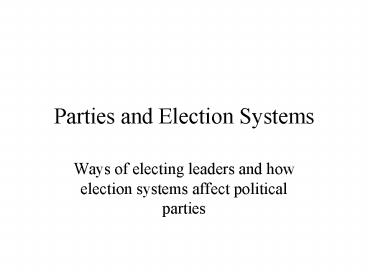Parties and Election Systems - PowerPoint PPT Presentation
1 / 22
Title:
Parties and Election Systems
Description:
Elections in China. People vote for representatives of the People's Congresses, who select members ... If many parties gain representation, coalitions form ... – PowerPoint PPT presentation
Number of Views:125
Avg rating:3.0/5.0
Title: Parties and Election Systems
1
Parties and Election Systems
- Ways of electing leaders and how election systems
affect political parties
2
A Thesis
- There is a correlation between the system used to
select leaders and the number and strength of
political parties that develop
3
China
- Basically, China is a one-party state
- There is dual rule in China rule by the
government and rule by the CCP - There are eight other officially recognized
parties, serving the function of interest groups - One party rule means the absence of opposition
4
Elections in China
- People vote for representatives of the Peoples
Congresses, who select members of the National
Party Congress - It is a rubber stamp legislature
- So, the election system in China doesnt have
much impact on the party system
5
Parties in Iran
- Parties were legalized in 1998
- They are weak and still developing
- Factions exist reformist, technocrats,
conservatives
6
Elections in Iran
- Elections are competitive, with high voter
turnout - Iran uses a FPTP/SMD system
- Candidates must be approved by the Guardian
Council
7
Comparing China and Iran
- In what respects are the electoral systems in
Iran and China alike? - Why dont electoral systems matter as much in
Iran and China?
8
FPTP/SMD Systems
- Winner-take all
- One winner per district
- Majority vote is not needed to win
- In some systems, there is a run-off election
9
Elections in the US
- Congress is selected using FPTP/SMD
- There is one winner in each House district,
whomever wins the most votes - The is one winner per election for the Senate,
whomever wins the most votes
10
Parties in the US
- There are two major parties
- FPTP/SMD encourages this
- So does the Electoral College
11
Elections in the UK
- The House of Commons is selected using a FPTP/SMD
system - The PM is chosen by the House of Commons, from
the majority party - This is a parliamentary system
12
Parties in the UK
- There are two main parties Conservative and
Labour - The Liberal Democrats serve as a third party
- There are regional parties
13
Elections and Parties in the UK
- What has been the impact of FPTP/SMD in the UK?
- Who would want to maintain this system?
- Why?
14
Parties in Nigeria
- There are two major parties The Peoples
Democratic Party (PDP) and the All Nigeria
Peoples Party (ANPP) - The Alliance for Democracy (AD) is a weak third
party
15
Elections in Nigeria
- The Senate is elected with three senators per
state - The House of Representatives uses SMD
- The president must receive a majority of the
votes, and 25 in each region - What is the reason for this requirement?
16
Proportional Representation
- Votes are cast for a party, not a candidate
- Parties are awarded vote based upon the
percentage of votes received - If many parties gain representation, coalitions
form
17
Parties in Russia
- United Russia--Putins party, the strongest
political party - CPRF--Communist Party, still garners much support
- Liberal Democrats--racist and nationalist
- Numerous smaller parties
18
Elections in Russia
- In 2003, 225 seats in the Duma were proportional
and 225 seats were SMD - In 2007, a party/list proportional system was
instituted, with a 7 threshold - Why did the Putin administration suggest this
change?
19
Mixed Systems
- Many countries combine elements of SMD with
Proportional Representation
20
Parties in Mexico
- PAN is the National Action Party, which is
conservative and pro-business - PRD, the Democratic Revolutionary Party, is
leftist and favors social welfare programs - PRI, the Institutional Revolutionary Party, used
patronage to maintain control
21
Elections in Mexico
- The Chamber of Deputies is elected using a mixed
system - 300 seats are winner-take-all
- 200 seats are proportional
- Why did the PRI establish this mixed system?
22
Testing the Thesis
- How do our six countries prove or disprove our
thesis that there is a correlation between
election systems and parties? - What is that correlation?































